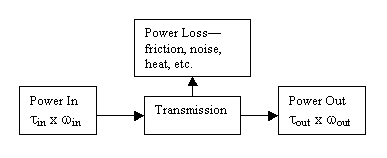 |
 |
| MANUAL TRANSMISSION (See also: Automaticl Transmission) | ||
| QUESTIONS OR COMMENTS | ||
 |
AUTHOR: | Gautam Jayaraman |
| E-MAIL: | gkj@mit.edu | |
| COURSE: | Undecided | |
| CLASS/YEAR: | 1 | |
MAIN FUNCTIONAL REQUIREMENT: Vary the torque and angular velocity of the power sent from the output shaft of the engine to the wheels.
DESIGN PARAMETER: Manual Transmission
GEOMETRY/STRUCTURE:
 |
| Schematic Of Manual Transmission |
EXPLANATION OF HOW IT WORKS/ IS USED:
Engines provide varying amounts of power at different efficiencies, depending on the speed at which they are turning. A transmission lets the driver select the ratio between the engine and wheels, so the engine can be run at speeds that provide more power, or at speeds that may be less powerful but allow the engine to operate more efficiently.
Power enters the transmission through the input shaft. The input shaft is connected to the engine via the clutch, such that when the clutch is engaged, power goes straight from the engine to the input shaft of the transmission, and the crankshaft and input shaft rotate at the same speed.
Just inside the housing of the transmission, the input shaft is connected to the countershaft (also known as the layshaft), by gears on both shafts, such that whenever the input shaft turns, so does the countershaft, and always at a fixed speed ratio.
In addition to the gear that takes power from the input shaft, the countershaft has several gears on it, one for each of the car’s "gears" including reverse. The diagram above depicts a five-speed manual transmission. All of these are connected to the countershaft, so they turn as a single piece.
A third shaft called the output shaft runs parallel to the countershaft, and has freely-rotating gears that are mounted on bearings and rotate independently of the output shaft. Each of these gears is paired with one of the countershaft gears, and is constantly in mesh with it. So actually the "freely-rotating" gears are constrained to rotate at a constant ratio with respect to the countershaft. Each pair of countershaft and output shaft gears represents one "gear" that the driver can select.
The free gears rotate at different speeds, depending on their size relative to that of the countershaft gear that powers them. This varying ratio between the countershaft gear and the output shaft gear is what ultimately determines the gear ratio. For the reverse gear there is a small "reverse idler gear" between the countershaft gear and the output shaft gear. This causes the reverse gear to turn the opposite way from the other gears on the output shaft.
The output shaft is a splined shaft that is more or less (via the differential) connected to the wheels. On the output shaft, between every pair of "free" gears is a collar. This is a round piece that is locked into the splines of the output shaft. By being attached to the shaft in this manner, the collar is forced to rotate with the shaft, but can slide up and down the shaft along the splines.
On the side surfaces of each collar are dog teeth that face toward the output shaft gears on either side. The "free" gears on the output shaft have slots into which the dog teeth can lock, forcing the gear to rotate with the collar.
To briefly summarize the operation of the manual transmission: The clutch sends power to the input shaft. This turns the countershaft as well as the "free" gears on the output shaft. When the driver selects a gear by moving the shift lever inside the car, a collar slides up to the appropriate "free" gear, and the dog teeth lock the collar to that gear. Thus power is transferred from the countershaft to the output shaft through the selected gear, at the appropriate ratio.
DOMINANT PHYSICS:
Whenever gears are used to transfer energy betweeen shafts, the rotation may be changed by a certain ratio, which is calculated in this case by multiplying the ratios of all the gear pairs that the power goes through.
There is a ratio between the input shaft and the countershaft, and another ratio between the chosen output shaft gear and its partner countershaft gear. When these two ratios are multiplied, the ratio for that "gear" of the transmission is obtained.
By changing the rotational speed of the engine’s power, the transmission is also changing the torque. Since torque and angular velocity vary inversely (assuming constant power , Power = Torque * Rotational Speed), a low gear provides slow rotation with high torque, and a high gear provides faster rotation with less torque.
 |
| Schematic Of Manual Transmission |
LIMITING PHYSICS:
There are certain limits that restrict the gearing of the manual transmission. The overall size of the gearbox is constrained, so that it can fit conveniently into the design of the vehicle. And since there are a finite number of gears to choose from (usually five), the optimal ratio cannot always be achieved.
Also the amount of torque input to the transmission cannot exceed a certain value, since excessive torque would cause failure of the gear teeth.
PLOTS/GRAPHS/TABLES:
None Submitted
WHERE TO FIND MANUAL TRANSMISSIONS:
These are found in all sorts of machinery, including race cars, buses, 18-wheelers, motorbikes, farm vehicles, and of course in passenger cars, where the hump between the seats is a constant reminder of the transmission’s presence.
REFERENCES/MORE INFORMATION:
Birch, Thomas. "Manual Drive Trains and Axles, 2nd ed." Columbus: Prentice Hall, 1999.
Brain, Marshall. "How Manual Transmissions Work." How Stuff Works. BYG Publishing, Inc. 1998.